‘Innovation Project Management’ (Second Edition) Features Content from Scott M. Graffius on Agile and Innovation
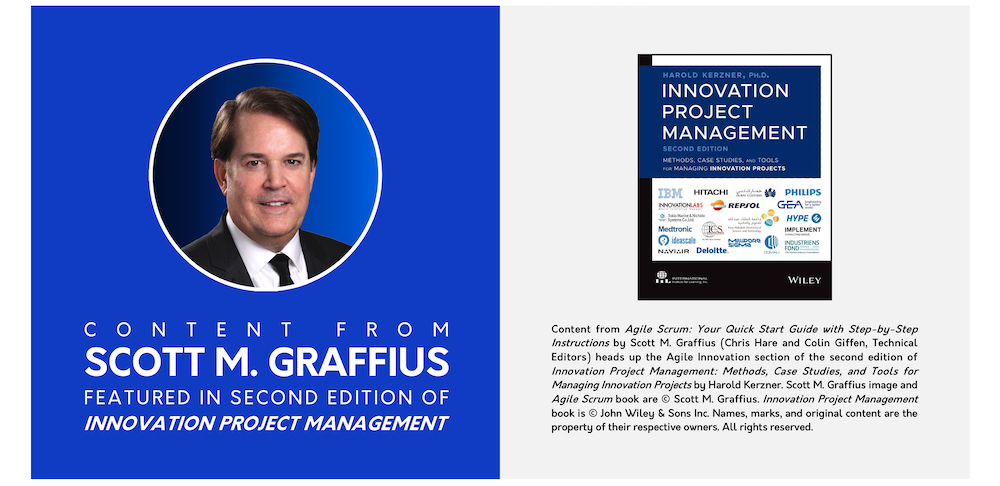
Click here to download this article as a PDF.
Content from Agile Scrum: Your Quick Start Guide with Step-by-Step Instructions by Scott M. Graffius (Chris Hare and Colin Giffen, Technical Editors) heads up the Agile Innovation section of the second edition of Innovation Project Management: Methods, Case Studies, and Tools for Managing Innovation Projects by Harold Kerzner. A view is shown below.
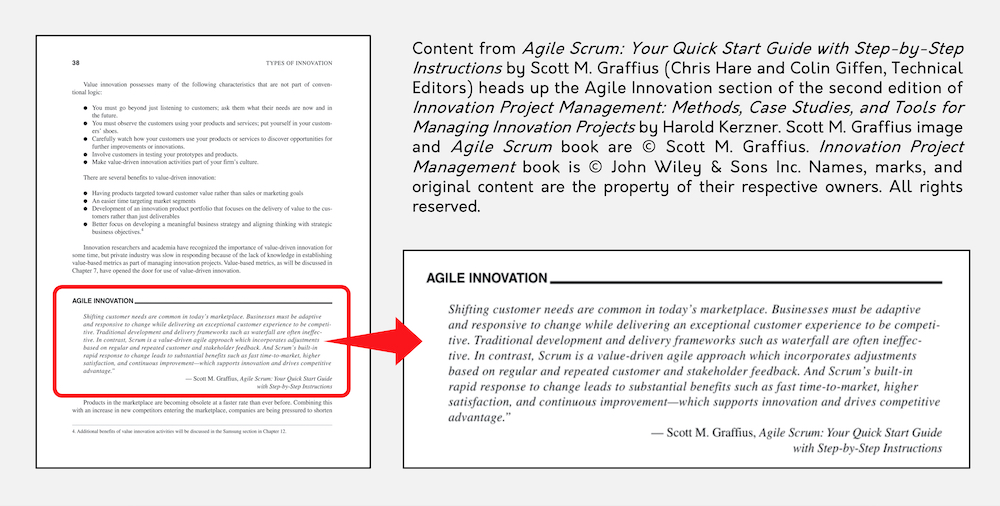

About Innovation Project Management: Methods, Case Studies, and Tools for Managing Innovation Projects by Harold Kerzner
The following information includes excerpts from the product description provided by the publisher.
The newly revised second edition of Innovation Project Management offers tools, processes, and metrics needed to successfully manage innovation projects, providing value-based innovation project management metrics as well as guidance for how to establish a metrics management program.
The highly qualified author analyzes innovation from all sides; through this approach, Innovation Project Management breaks down traditional project management methods and explains why and how innovation projects should be managed differently.
The second edition has exclusive insights from world-class organizations such as IBM, Hitachi, Repsol, Philips, Deloitte, IdeaScale, KAUST, and more. It includes six all new case studies, featuring a dive into brand management innovation from Lego.
Some of the ideas discussed in Innovation Project Management include:
- Continuous versus discontinuous innovation, incremental versus radical innovation, understanding innovation differences, and incremental innovation versus new product development.
- Identifying core competencies using strengths, weaknesses, opportunities, and threats (SWOT) analysis and nondisclosure and confidentiality agreements.
- Implications and issues for project managers and innovation personnel, active listening, pitching the innovation, and cognitive biases.
- Measuring intangible assets, customer/user/stakeholder impact on value metrics, customer value management programs, and the relationship between project management and value.
- With its highly detailed and comprehensive coverage of the field, and with case studies from leading companies to show how concepts are applied in real-world situations, Innovation Project Management is a must-have title for practicing project managers, as well as students in project management, innovation, and entrepreneurship programs.
To learn more, visit here.



About Scott M. Graffius

Scott M. Graffius, PMP, CSP-SM, CSP-PO, CSM, CSPO, SFE, ITIL, LSSGB is an agile project management practitioner, consultant, multi award-winning author, and highly sought-after international keynote speaker. He has generated over $1.75 billion of business value in aggregate for the organizations he has served. Graffius is the CEO and Principal Consultant at Exceptional PPM and PMO Solutions™ and subsidiary Exceptional Agility™. Content from his books, talks, workshops, and more have been featured and used by businesses, professional associations, governments, and universities. Select examples include Microsoft, Oracle, Broadcom, Cisco, Gartner, Project Management Institute, IEEE, U.S. Soccer Federation, Qantas, National Academy of Sciences, U.S. Department of Energy, U.S. National Park Service, New Zealand Ministry of Education, Yale University, Warsaw University of Technology, and others. Graffius has delighted audiences with dynamic and engaging talks and workshops on agile, project management, and technology leadership at 82 conferences and other events across 24 countries.
His full bio is available here.
Connect with Scott on:
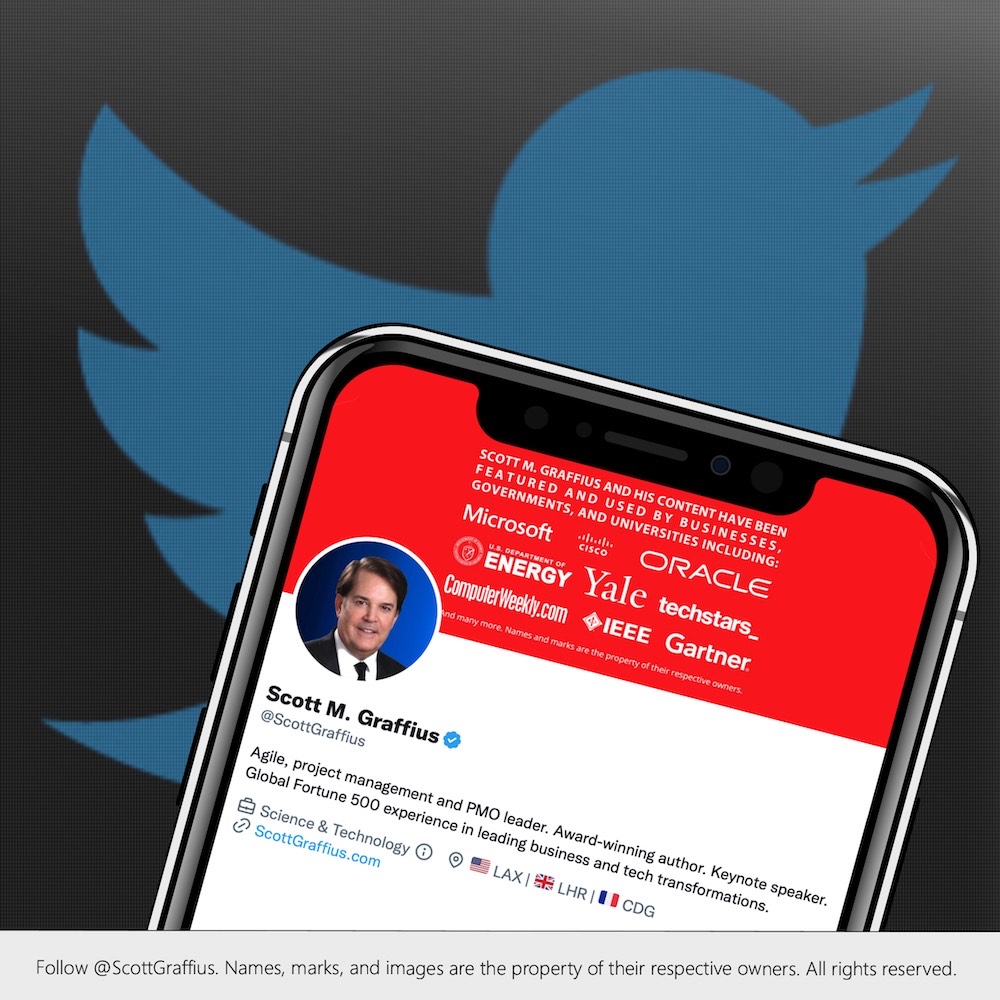

About Agile Scrum: Your Quick Start Guide with Step-by-Step Instructions
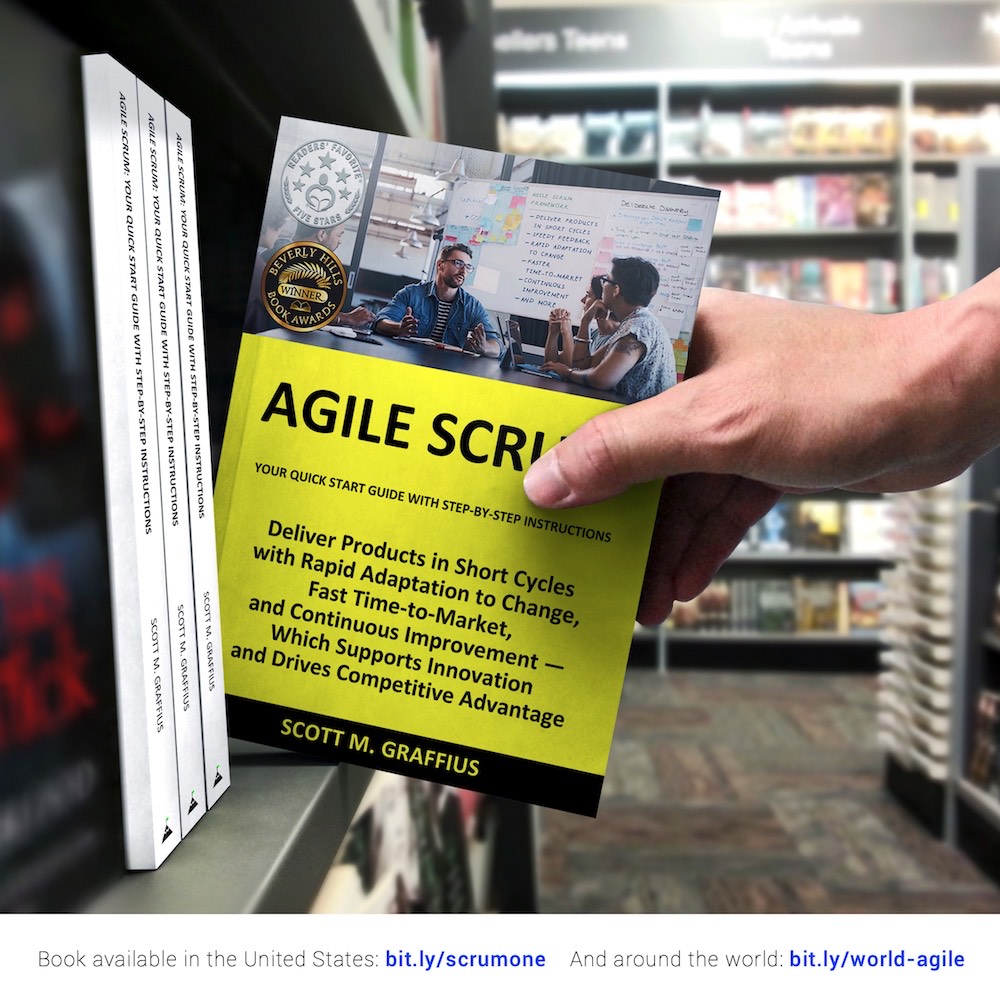
Shifting customer needs are common in today's marketplace. Businesses must be adaptive and responsive to change while delivering an exceptional customer experience to be competitive.
There are a variety of frameworks supporting the development of products and services, and most approaches fall into one of two broad categories: traditional or agile. Traditional practices such as waterfall engage sequential development, while agile involves iterative and incremental deliverables. Organizations are increasingly embracing agile to manage projects, and best meet their business needs of rapid response to change, fast delivery speed, and more.
With clear and easy to follow instructions, the multi award-winning Agile Scrum: Your Quick Start Guide with Step-by-Step Instructions book by Scott M. Graffius (Chris Hare and Colin Giffen, Technical Editors) helps the reader:
- Implement and use the most popular agile framework―Scrum;
- Deliver products in short cycles with rapid adaptation to change, fast time-to-market, and continuous improvement; and
- Support innovation and drive competitive advantage.
Hailed by Literary Titan as “the book highlights the versatility of Scrum beautifully.”
Winner of 17 first place awards.
Agile Scrum: Your Quick Start Guide with Step-by-Step Instructions is available in paperback and ebook/Kindle in the United States and around the world. Some links by country follow.
- 🇧🇷 Brazil
- 🇨🇦 Canada
- 🇨🇿 Czech Republic
- 🇩🇰 Denmark
- 🇫🇮 Finland
- 🇫🇷 France
- 🇩🇪 Germany
- 🇬🇷 Greece
- 🇭🇺 Hungary
- 🇮🇳 India
- 🇮🇪 Ireland
- 🇮🇱 Israel
- 🇮🇹 Italy
- 🇯🇵 Japan
- 🇱🇺 Luxembourg
- 🇲🇽 Mexico
- 🇳🇱 Netherlands
- 🇳🇿 New Zealand
- 🇳🇴 Norway
- 🇪🇸 Spain
- 🇸🇪 Sweden
- 🇨🇭 Switzerland
- 🇦🇪 UAE
- 🇬🇧 United Kingdom
- 🇺🇸 United States

About Agile Transformation: A Brief Story of How an Entertainment Company Developed New Capabilities and Unlocked Business Agility to Thrive in an Era of Rapid Change
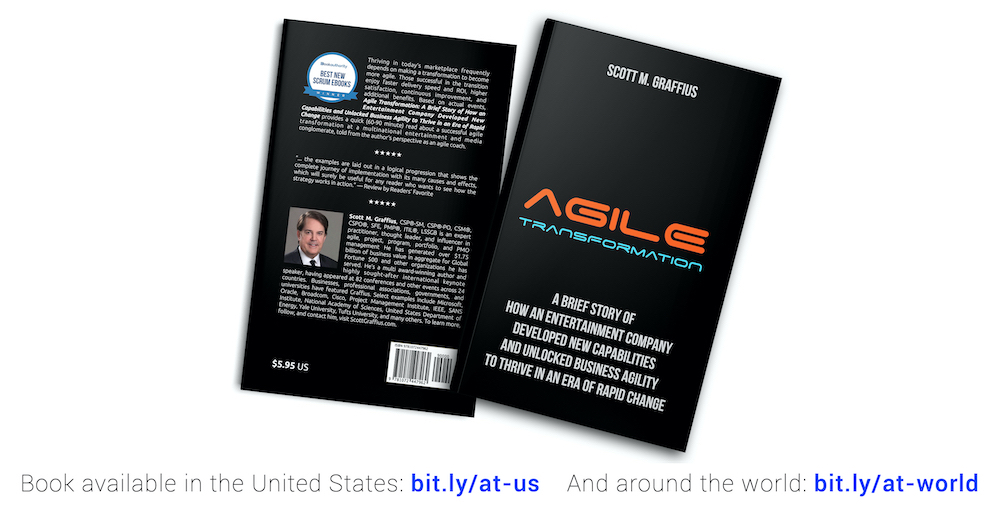
Thriving in today's marketplace frequently depends on making a transformation to become more agile. Those successful in the transition enjoy faster delivery speed and ROI, higher satisfaction, continuous improvement, and additional benefits.
Based on actual events, Agile Transformation: A Brief Story of How an Entertainment Company Developed New Capabilities and Unlocked Business Agility to Thrive in an Era of Rapid Change provides a quick (60-90 minute) read about a successful agile transformation at a multinational entertainment and media company, told from the author's perspective as an agile coach.
The award-winning book by Scott M. Graffius is available in paperback and ebook/Kindle in the United States and around the world. Some links by country follow.
- 🇦🇺 Australia
- 🇦🇹 Austria
- 🇧🇷 Brazil
- 🇨🇦 Canada
- 🇨🇿 Czech Republic
- 🇩🇰 Denmark
- 🇫🇮 Finland
- 🇫🇷 France
- 🇩🇪 Germany
- 🇬🇷 Greece
- 🇮🇳 India
- 🇮🇪 Ireland
- 🇯🇵 Japan
- 🇱🇺 Luxembourg
- 🇲🇽 Mexico
- 🇳🇱 Netherlands
- 🇳🇿 New Zealand
- 🇪🇸 Spain
- 🇸🇪 Sweden
- 🇨🇭 Switzerland
- 🇦🇪 United Arab Emirates
- 🇬🇧 United Kingdom
- 🇺🇸 United States

#Agile #Agility #AgileCoach #AgileInnovation #AgileProjectManagement #AgileScrumGuide #Business #Change #Collaboration #CompetitiveAdvantage #ContinuousImprovement #Development #HaroldKerzner #Innovation #InnovationManagement
#InnovationProjectManagement #Kerzner #Leadership #NPD #OrganizationalDevelopment #ProductDevelopment #ProjectManagement #ProjectManagement #ProjectManager #Scrum #ScrumMaster #SDLC #Stakeholders #Tech #Technology
The short URL for this article is: https://bit.ly/innov-23
© Copyright 2023 Scott M. Graffius. All rights reserved. This material may not be published, broadcast, rewritten or redistributed without the express written permission of Scott M. Graffius.

Agile's Journey Through the Decades


Introduction
Agile has come a long way since its early days, evolving through decades of adaptation and innovation. What began as a response to rigid development practices has become a global movement, influencing industries beyond software. Along the way, principles and practices have shaped how teams collaborate and deliver value. This article (and the related infographic) takes you through Agile’s history, highlighting key moments that have defined its evolution. Discover the decades of transformation that keep Agile evolving and relevant in today’s world.

Agile Through the Decades
The 1950s
- 1957: IBM began utilizing incremental development in software projects.
- 1958: Software for Project Mercury, the United States’ first human spaceflight program, was developed in half-day iterations.
The 1960s
- 1968: IBM’s Harlan Mills advocated for staged, incremental software development with continuous user involvement.
The 1970s
[Agile took a Disco Nap]
The 1980s
- 1980: Toyota introduced visual control, a predecessor to Agile’s information radiators.
- 1984: Leo Brodie described the concept of factoring, an early influence on code structuring.
- 1985: Tom Gilb introduced the Evolutionary Delivery Model, an alternative to the Waterfall methodology.
- 1986: The influential article "The New New Product Development Game" by Hirotaka Takeuchi and Ikujiro Nonaka was published in the Harvard Business Review, laying the groundwork for Scrum.
- 1988: The timebox approach was central to DuPont’s Rapid Iterative Production Prototyping.
The 1990s
- 1990: Bill Opdyke coined the term refactoring, which became fundamental in Agile software development.
- 1991: James Martin described timeboxing and iterations, core components of Agile frameworks.
- 1993:Jim Coplien introduced the stand-up meeting pattern. Scrum was first used as a process by Jeff Sutherland, John Scumniotales, and Jeff McKenna at Easel Corporation.
- 1994: Alistair Cockburn advocated working in increments.
- 1995: Ken Schwaber and Jeff Sutherland co-presented Scrum.
- 1997: Ken Schwaber described the daily Scrum.
- 1998: The Chrysler Goes to Extremes case study detailed Extreme Programming (XP) practices like self-chosen tasks, three-week iterations, and pair programming.
The 2000s
- 2000: Martin Fowler published an article defining continuous integration. Ken Schwaber introduced the burndown chart.
- 2001: Seventeen software development experts—Kent Beck, Mike Beedle, Arie van Bennekum, Alistair Cockburn, Ward Cunningham, Martin Fowler, Robert C. Martin, Steve Mellor, Dave Thomas, James Grenning, Jim Highsmith, Andrew Hunt, Ron Jeffries, Jon Kern, Brian Marick, Ken Schwaber, and Jeff Sutherland—formulated the Manifesto for Agile Software Development, emphasizing individuals and interactions, working software, customer collaboration, and responding to change. Mary Poppendieck highlighted Agile’s similarities with Lean manufacturing. Alistair Cockburn coined the term information radiator.
- 2005: Mike Cohn’s Agile Estimating and Planning introduced techniques such as Planning Poker.
- 2008: Kane Mar formally described backlog grooming. Jeff Patton introduced story mapping.
- 2009: The concept of DevOps emerged from John Allspaw and Paul Hammond’s talk on 10+ daily deployments, while Patrick Debois coined the term.
The 2010s to Present
- 2010: Dean Leffingwell and Drew Jemilo introduced the Scaled Agile Framework (SAFe), designed for enterprise-level Agile adoption.

Conclusion
Agile has continually evolved, proving its resilience and relevance across industries. It adapts to new challenges and innovations. And its core principles of collaboration, flexibility, and continuous improvement remain as vital as ever.
Scott M. Graffius developed a related infographic—'Agile's History, Visualized'—and released it via Exceptional Agility AI. It's also available here.
Many individuals and organizations have made valuable contributions to Agile. This article highlights select major milestones and is not intended to be an exhaustive list.

Read on for:
- About Scott M. Graffius,
- How to cite this article,
- and more.

About Scott M. Graffius

Scott M. Graffius sparks breakthroughs in AI, agile, and project management/PMO leadership as a globally recognized practitioner, researcher, thought leader, award-winning author, and international public speaker.
Graffius has generated more than USD $1.9 billion in business value for organizations served, including Fortune 500 companies. Businesses and industries range from technology (including R&D and AI) to entertainment, financial services, and healthcare, government, social media, and more.
Graffius leads the professional services firm Exceptional PPM and PMO Solutions, along with its subsidiary Exceptional Agility. These consultancies offer strategic and tactical advisory, training, embedded talent, and consulting services to public, private, and government sectors. They help organizations enhance their capabilities and results in agile, project management, program management, portfolio management, and PMO leadership, supporting innovation and driving competitive advantage. The consultancies confidently back services with a Delighted Client Guarantee™. Graffius is a former vice president of project management with a publicly traded provider of diverse consumer products and services over the Internet. Before that, he ran and supervised the delivery of projects and programs in public and private organizations with businesses ranging from e-commerce to advanced technology products and services, retail, manufacturing, entertainment, and more. He has experience with consumer, business, reseller, government, and international markets.
He is the author of two award-winning books.
- His first book, Agile Scrum: Your Quick Start Guide with Step-by-Step Instructions (ISBN-13: 9781533370242), received 17 awards.
- His second book is Agile Transformation: A Brief Story of How an Entertainment Company Developed New Capabilities and Unlocked Business Agility to Thrive in an Era of Rapid Change (ISBN-13: 9781072447962). BookAuthority named it one of the best Scrum books of all time.
Prominent businesses, professional associations, government agencies, and universities have featured Graffius and his work including content from his books, talks, workshops, and more. Select examples include:
- Adobe,
- American Management Association,
- Amsterdam Public Health Research Institute,
- Bayer,
- BMC Software,
- Boston University,
- Broadcom,
- Cisco,
- Coburg University of Applied Sciences and Arts Germany,
- Computer Weekly,
- Constructor University Germany,
- Data Governance Success,
- Deimos Aerospace,
- DevOps Institute,
- EU's European Commission,
- Ford Motor Company,
- Gartner
- GoDaddy,
- Harvard Medical School,
- Hasso Plattner Institute Germany,
- IEEE,
- Innovation Project Management,
- Johns Hopkins University,
- Journal of Neurosurgery,
- Lam Research (Semiconductors),
- Leadership Worthy,
- Life Sciences Trainers and Educators Network,
- London South Bank University,
- Microsoft,
- NASSCOM,
- National Academy of Sciences,
- New Zealand Government,
- Oracle,
- Pinterest Inc.,
- Project Management Institute,
- SANS Institute,
- SBG Neumark Germany,
- Singapore Institute of Technology,
- Torrens University Australia,
- TBS Switzerland,
- Tufts University,
- UC San Diego,
- UK Sports Institute,
- University of Galway Ireland,
- US Department of Energy,
- US National Park Service,
- US Tennis Association,
- Veleučilište u Rijeci Croatia,
- Verizon,
- Virginia Tech,
- Warsaw University of Technology,
- Wrike,
- Yale University,
- and many others.
Graffius has been actively involved with the Project Management Institute (PMI) in the development of professional standards. He was a member of the team which produced the Practice Standard for Work Breakdown Structures—Second Edition. Graffius was a contributor and reviewer of A Guide to the Project Management Body of Knowledge—Sixth Edition, The Standard for Program Management—Fourth Edition, and The Practice Standard for Project Estimating—Second Edition. He was also a subject matter expert reviewer of content for the PMI’s Congress. Beyond the PMI, Graffius also served as a member of the review team for two of the Scrum Alliance’s Global Scrum Gatherings.
Graffius has a bachelor’s degree in psychology with a focus in Human Factors. He holds eight professional certifications:
- Certified SAFe 6 Agilist (SA),
- Certified Scrum Professional - ScrumMaster (CSP-SM),
- Certified Scrum Professional - Product Owner (CSP-PO),
- Certified ScrumMaster (CSM),
- Certified Scrum Product Owner (CSPO),
- Project Management Professional (PMP),
- Lean Six Sigma Green Belt (LSSGB), and
- IT Service Management Foundation (ITIL).
He is an active member of the Scrum Alliance, the Project Management Institute (PMI), and the Institute of Electrical and Electronics Engineers (IEEE).
He divides his time between Los Angeles and Paris, France.
Thought Leader | Public Speaker | Agile Scrum Book | Agile Transformation Book | Blog | Photo | X | LinkedIn | Email


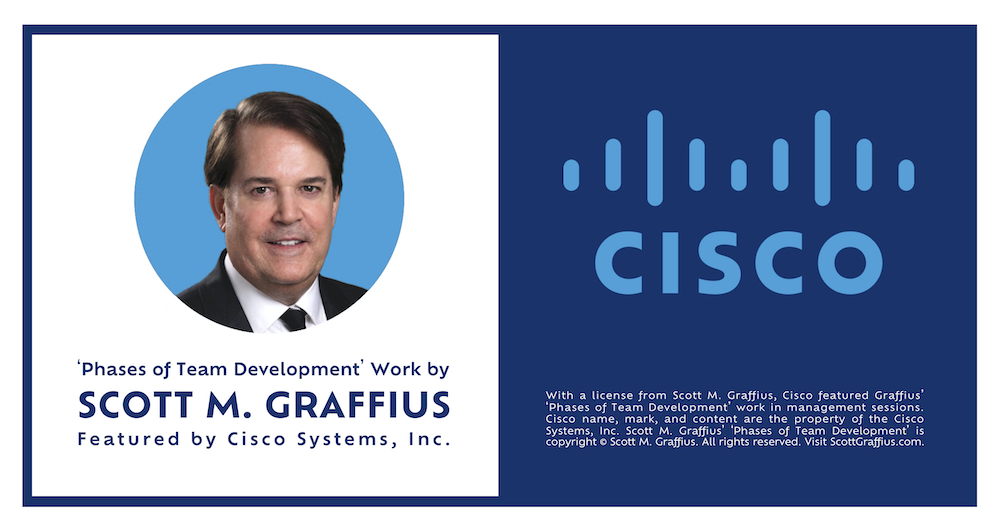










Sign up for Miro—it's free!
(Want more features? You can always upgrade to a paid plan.)


How to Cite This Article
Graffius, Scott M. (2025, February 21). Agile's Journey Through the Decades. Available at: https://scottgraffius.com/blog/files/agile's-journey-through-the-decades.html.
Scott M. Graffius wrote this article. He wrote a related article at Exceptional Agility AI. 

Copyright
Copyright © Scott M. Graffius. All rights reserved.
Content on this site—including text, images, videos, and data—may not be used for training or input into any artificial intelligence, machine learning, or automatized learning systems, or published, broadcast, rewritten, or redistributed without the express written permission of Scott M. Graffius.
Dropbox Company (Nira) Taps into Scott M. Graffius’ Expertise in Strategic Planning

Introduction
In 2024, Dropbox, a leader in cloud storage and collaboration, broadened its vision by acquiring Nira, a company focused on boosting team productivity through innovative tools. This acquisition aligned with the launch of Dropbox Dash for Business, an AI-powered universal search tool designed to streamline workflows for over 1 billion knowledge workers worldwide.
Scott M. Graffius is honored that Dropbox company Nira has recognized his expertise in strategic planning by featuring his work in their article on retrospective meetings, credited as "Adapted by FYI from Scott Graffius" and "www.scottgraffius.com." Views follow.

This nod highlights the power of strategic planning in fostering clarity and impact—core values that resonate with Dropbox’s mission. This article explores how this recognition underscores the rising value of structured collaboration in today’s dynamic work landscape.
Main Body
Impact mapping turns abstract goals into actionable steps. It addresses four key questions—Why? Who? How? What?—to create a visual roadmap linking objectives, stakeholders, desired impacts, and deliverables. By charting the "shortest path" to success, it helps teams prioritize the most effective actions. Nira’s article on retrospective meetings—a process where teams reflect on past sprints/projects to improve future outcomes—demonstrates how impact mapping elevates this practice. By charting the effects of deliverables on key stakeholders, teams can identify what delivered value and where refinements are needed, transforming retrospectives into a springboard for progress.
Dropbox’s 2024 acquisition of Nira amplifies this emphasis on productivity and alignment. With Dash for Business, Dropbox addresses information overload by integrating search across platforms like Google Workspace and Asana, tapping into an $8 billion universal search market set to double in size. Impact mapping complements this innovation by offering strategic clarity, enabling teams to maximize tools. Nira’s inclusion of Graffius’ work signals how strategic planning bridges intent and execution, aligning with Dropbox’s aim to simplify collaboration.
Conclusion
For Graffius, recognition from Dropbox's Nira is a meaningful affirmation of universal relevance of strategic planning. He is eager to see how Dropbox continues to embed strategic clarity into its growing suite of solutions. This milestone strengthens his commitment to advancing strategic planning, shaping the future of collaboration with precision and purpose.
To learn more about impact mapping, read this article.
Read on for:
- About Nira,
- About Dropbox,
- About Scott M. Graffius,
- How to Cite This Article,
- and more.

About Nira
Nira, acquired by Dropbox, is a content governance platform that provides a suite of in-depth functionality to protect cloud files from unauthorized access. With Nira, Dropbox designed a custom solution built directly into Dash, so businesses can easily protect confidential documents in just a few clicks. Admins can now see everything that’s been shared in their company, across every major content platform, in one place. Then, they can identify sensitive content and manage bulk changes for any number of assets at once—eliminating a previously tedious and manual document-by-document process.

About Dropbox
Dropbox is the one place to keep life organized and keep work moving. With more than 700 million registered users across approximately 180 countries, it’s on a mission to design a more enlightened way of working. Dropbox is headquartered in San Francisco, California, and has employees around the world. For more information, visit https://dropbox.com.

About Scott M. Graffius

Scott M. Graffius sparks breakthroughs in AI, agile, and project management/PMO leadership as a globally recognized practitioner, researcher, thought leader, award-winning author, and international public speaker.
Graffius has generated more than USD $1.9 billion in business value for organizations served, including Fortune 500 companies. Businesses and industries range from technology (including R&D and AI) to entertainment, financial services, and healthcare, government, social media, and more.
Graffius leads the professional services firm Exceptional PPM and PMO Solutions, along with its subsidiary Exceptional Agility. These consultancies offer strategic and tactical advisory, training, embedded talent, and consulting services to public, private, and government sectors. They help organizations enhance their capabilities and results in agile, project management, program management, portfolio management, and PMO leadership, supporting innovation and driving competitive advantage. The consultancies confidently back services with a Delighted Client Guarantee™. Graffius is a former vice president of project management with a publicly traded provider of diverse consumer products and services over the Internet. Before that, he ran and supervised the delivery of projects and programs in public and private organizations with businesses ranging from e-commerce to advanced technology products and services, retail, manufacturing, entertainment, and more. He has experience with consumer, business, reseller, government, and international markets.
He is the author of two award-winning books.
- His first book, Agile Scrum: Your Quick Start Guide with Step-by-Step Instructions (ISBN-13: 9781533370242), received 17 awards.
- His second book is Agile Transformation: A Brief Story of How an Entertainment Company Developed New Capabilities and Unlocked Business Agility to Thrive in an Era of Rapid Change (ISBN-13: 9781072447962). BookAuthority named it one of the best Scrum books of all time.
Prominent businesses, professional associations, government agencies, and universities have featured Graffius and his work including content from his books, talks, workshops, and more. Select examples include:
- Adobe,
- American Management Association,
- Amsterdam Public Health Research Institute,
- Bayer,
- BMC Software,
- Boston University,
- Broadcom,
- Cisco,
- Coburg University of Applied Sciences and Arts Germany,
- Computer Weekly,
- Constructor University Germany,
- Data Governance Success,
- Deimos Aerospace,
- DevOps Institute,
- EU's European Commission,
- Ford Motor Company,
- GoDaddy,
- Harvard Medical School,
- Hasso Plattner Institute Germany,
- IEEE,
- Innovation Project Management,
- Johns Hopkins University,
- Journal of Neurosurgery,
- Lam Research (Semiconductors),
- Leadership Worthy,
- Life Sciences Trainers and Educators Network,
- London South Bank University,
- Microsoft,
- NASSCOM,
- National Academy of Sciences,
- New Zealand Government,
- Oracle,
- Pinterest Inc.,
- Project Management Institute,
- SANS Institute,
- SBG Neumark Germany,
- Singapore Institute of Technology,
- Torrens University Australia,
- TBS Switzerland,
- Tufts University,
- UC San Diego,
- UK Sports Institute,
- University of Galway Ireland,
- US Department of Energy,
- US National Park Service,
- US Tennis Association,
- Veleučilište u Rijeci Croatia,
- Verizon,
- Virginia Tech,
- Warsaw University of Technology,
- Wrike,
- Yale University,
- and many others.
Graffius has been actively involved with the Project Management Institute (PMI) in the development of professional standards. He was a member of the team which produced the Practice Standard for Work Breakdown Structures—Second Edition. Graffius was a contributor and reviewer of A Guide to the Project Management Body of Knowledge—Sixth Edition, The Standard for Program Management—Fourth Edition, and The Practice Standard for Project Estimating—Second Edition. He was also a subject matter expert reviewer of content for the PMI’s Congress. Beyond the PMI, Graffius also served as a member of the review team for two of the Scrum Alliance’s Global Scrum Gatherings.
Graffius has a bachelor’s degree in psychology with a focus in Human Factors. He holds eight professional certifications:
- Certified SAFe 6 Agilist (SA),
- Certified Scrum Professional - ScrumMaster (CSP-SM),
- Certified Scrum Professional - Product Owner (CSP-PO),
- Certified ScrumMaster (CSM),
- Certified Scrum Product Owner (CSPO),
- Project Management Professional (PMP),
- Lean Six Sigma Green Belt (LSSGB), and
- IT Service Management Foundation (ITIL).
He is an active member of the Scrum Alliance, the Project Management Institute (PMI), and the Institute of Electrical and Electronics Engineers (IEEE).
He divides his time between Los Angeles and Paris, France.
Thought Leader | Public Speaker | Agile Scrum Book | Agile Transformation Book | Blog | Photo | X | LinkedIn | Email













Sign up for Miro—it's free!
(Want more features? You can always upgrade to a paid plan.)


How to Cite This Article
Graffius, Scott M. (2025, March 21). Reporting Errors in 'Frontiers in Public Health': A Case Study. Available at: https://scottgraffius.com/blog/files/dropbox-taps-into-scott-m-graffius-expertise-in-strategic-planning.html. 

Digital Object Identifier (DOI)
DOI: (coming soon)

Content Acknowledgements
This article includes brief excerpts from content ('12 Tricks for Running a Retrospective Meeting that People Actually Enjoy') by Dropbox company Nira, attributed and used under fair use for news reporting and analysis. Dropbox name and mark are the property of Dropbox Inc. Nira is the property of Dropbox Inc.

Post-Publication Notes
If there's an update after this article is published, the information will appear here.

Copyright
Copyright © Scott M. Graffius. All rights reserved.
Content on this site—including text, images, videos, and data—may not be used for training or input into any artificial intelligence, machine learning, or automatized learning systems, or published, broadcast, rewritten, or redistributed without the express written permission of Scott M. Graffius.
